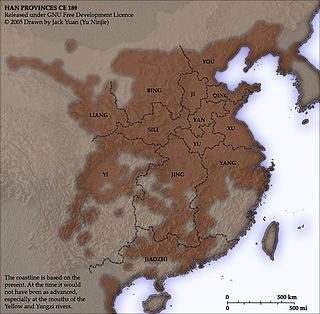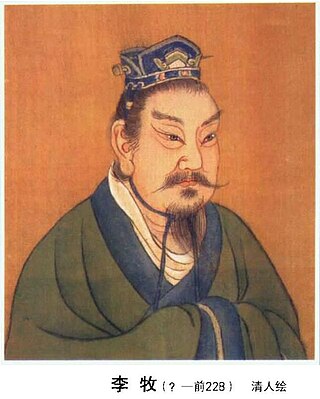
Zhao was one of the seven major states during the Warring States period of ancient China. It emerged from the tripartite division of Jin, along with Han and Wei, in the 5th century BC. Zhao gained considerable strength from the military reforms initiated during the reign of King Wuling, but suffered a crushing defeat at the hands of Qin at the Battle of Changping. Its territory included areas in the modern provinces of Inner Mongolia, Hebei, Shanxi and Shaanxi. It bordered the states of Qin, Wei, and Yan, as well as various nomadic peoples including the Hu and Xiongnu. Its capital was Handan, in modern Hebei province.
Shibi Khagan succeeded Yami Qaghan as the second khagan of the Eastern Turkic Khaganate.

You Prefecture or YouProvince, also known by its Chinese name Youzhou, was a prefecture (zhou) in northern China during its imperial era.

Li Mu, personal name Zuo (繓), courtesy name Mu (牧), was a Chinese military General of the State of Zhao during the Warring States period. He is regarded by Chinese folklore as one of the four Greatest Generals of the Late Warring States period, along with Bai Qi, Wang Jian, and Lian Po. He's widely considered as one of the best defensive tacticians commanders of ancient warfare.

Dai County, also known by its Chinese name Daixian, is a county in Xinzhou, Shanxi Province, China. Its county seat at Shangguan is also known as Daixian. The county has an area of 1,729 km2 (668 sq mi) and had a population of 178,870 at the time of the 2020 census. The county is the home of the AAAAA-rated Yanmen Pass Scenic Area along the Great Wall, as well as the Bianjing Drum Tower, the Ayuwang Pagoda, and the Zhao Gao Forest Park.

Cao Shen or Cao Can, courtesy name Jingbo, was a Chinese politician. He served as a chancellor of the Western Han dynasty. He participated in the Chu–Han Contention on Liu Bang 's side and contributed greatly to the founding of the Han dynasty.

Yu County, also known by its Chinese name Yuxian, is a county under the jurisdiction of the prefecture-level city of Zhangjiakou in northwestern Hebei province, China. Yuzhou (蔚州镇) is the county seat.

Qin's wars of unification were a series of military campaigns launched in the late 3rd century BC by the Qin state against the other six major Chinese states — Han, Zhao, Yan, Wei, Chu and Qi.

Loufan County is a county of Shanxi Province, North China, it is under the administration of the prefecture-level city of Taiyuan, the capital of the province. It is the westernmost county-level division of Taiyuan.
Yanggao County is a county in the northeast of Shanxi province, China, bordering Inner Mongolia to the northwest and Hebei province to the east. It is under the administration of the prefecture-level city of Datong.

Hunyuan County is a county under the administration of Datong City, in the northeast of Shanxi province, China.

Shuocheng District, formerly Shuo County, is the main urban district of the prefecture-level city of Shuozhou in Shanxi province, China.

Youyu County, also known by its Chinese name Youyuxian, is a county under the administration of the prefecture-level city of Shuozhou, in the northwest of Shanxi Province, China. It borders Inner Mongolia to the north and west.

Yanmen Pass, also known by its Chinese name Yanmenguan and as Xixingguan, is a mountain pass which includes three fortified gatehouses along the Great Wall of China. The area was a strategic choke point in ancient and medieval China, controlling access between the valleys of central Shanxi and the Eurasian Steppe. This made it the scene of various important battles, extending into World War II, and the area around the gatehouses and this stretch of the Great Wall is now a AAAAA-rated tourist attraction. The scenic area is located just outside Yanmenguan Village in Yanmenguan Township in Dai County, Xinzhou City, Shanxi Province, China.

Dai was a state which existed in northern Hebei during the Spring and Autumn Period of Chinese history. Its eponymous capital was located north of the Zhou Kingdom in what is now Yu County. It was apparently established by the people known to the ancient Chinese as the Baidi or "White Barbarians". They traded livestock and other goods between Central Asia and the Zhou states prior to their conquest by the Zhao clan of Jin.
Jia, King of Zhao, also known as Jia, King of Dai (代王嘉), Zhao Jia (趙嘉), was the last ruler of the state of Zhao during the waning days of the Warring States Period of Chinese history. His realm was a rump state that covered only a northern fraction of the former Zhao territories.

Dai was a short-lived state from 228 BC to 222 BC during the Warring States period of Chinese history. Prince Zhao Jia, older brother of King Youmiu of Zhao, fled with the remnant forces to Dai Commandery after the conquest of Zhao and was proclaimed the new king of Zhao. His rump state was conquered in the year 222 BC by Qin during its campaigns against Yan. The ruins of his capital are preserved in present-day Yu County, Hebei, as "Dai King City" (代王城).

Dai Prefecture, also known by its Chinese name Daizhou, was a prefecture (zhou) of imperial China in what is now northern Shanxi. It existed intermittently from AD 585 to 1912. Its eponymous seat Daizhou was located at Shangguan in Dai County. The territory it administered included all or part of what are now the counties of Dai, Wutai, Fanshi, and Yuanping in Shanxi's Xinzhou Prefecture.
Yanmen Commandery was an administrative subdivision (jùn) of the state of Zhao established c. 300 BC and of northern imperial Chinese dynasties until AD 758. It occupied lands in what is now Shanxi and Inner Mongolia. Its first seat was at Shanwu ; its later seats moved southeast to the more defensible sites at Yinguan and Guangwu.
Chen Xi was a Chinese rebel leader against the first Han emperor Liu Bang.





















